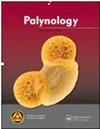巴西阿卡州巴布兰科市区采得的四爪蝇花粉的植物来源和季节变化
IF 1.3
4区 地球科学
Q3 PALEONTOLOGY
引用次数: 0
摘要
摘要采用孢粉学(花粉鉴定)方法,对温氏拮抗剂采集的花粉的植物学来源和季节变化进行了研究。这项研究于2016年8月至2017年7月进行,在联邦阿克里大学(UFAC)校园附近的城市地区(09°56′38.7〃S;67°52′42.9〃W)的一个住宅花园中引入了一个蜂巢。我们总共鉴定了31个植物科的87种花粉类型,其中最具代表性的是:泽泻科、苋科、槟榔科、紫草科、莎草科、大戟科、蚕豆科和荨麻科,它们的比例都在10%以上。花粉类型Alternathera(苋科)、Cecropia(荨麻科)和Cordia sellowiana(紫草科)的相对丰度超过90%,因此被认为是暂时特化事件。多样性和均匀度值最低的是七月(H′=0.127;J′=0.071)和八月(H′=0.070;J′0.043),最高的是十月(H′=2.025;J′=0.715)和四月(H′=1.941;J′0.611),因此与雨季(11月至4月)或旱季(5月至10月)无关。此外,蜜蜂对花粉的形态特征(如大小、外壁结构或孔径数)没有偏好。然而,最具代表性的颗粒是中小型,这强化了这种蜜蜂更喜欢密集花序中的小花的假设。本文章由计算机程序翻译,如有差异,请以英文原文为准。
Botanical origin and seasonal variation in pollen collected by Tetragonisca weyrauchi (Apidae: Meliponini) in an urban area of Rio Branco, State of Acre, Brazil
Abstract The botanical origin and seasonal variation of pollen collected by Tetragonisca weyrauchi were studied by means of palynology (pollen identification). The study was carried out between August 2016 and July 2017 with a hive introduced in a house garden in an urban area (09° 56′ 38.7″ S; 67° 52′ 42.9″ W) near the campus of the Federal University of Acre (UFAC). In total, we identified 87 pollen types from 31 botanical families, with the most representative ones being: Alismataceae, Amaranthaceae, Arecaceae, Boraginaceae, Cyperaceae, Euphorbiaceae, Fabaceae and Urticaceae, all displaying percentages above 10%. The pollen types Alternanthera (Amaranthaceae), Cecropia (Urticaceae) and Cordia sellowiana (Boraginaceae) obtained relative abundances above 90% and are therefore considered events of temporary specialization. The lowest diversity and evenness values were found for July (H′ = 0.127; J′ = 0.071) and August (H′ = 0.070; J′ = 0.043), and the highest values for October (H′ = 2.025; J′ = 0.715) and April (H′ = 1.941; J′ = 0.611), thus not suggesting relationships with the rainy (November–April) or dry (May–October) periods. Furthermore, there was no preference by the bees for morphological characteristics of the pollen such as size, exine texture or aperture number. However, the most representative grains are among the small and medium size, reinforcing the hypothesis that this bee species prefers small flowers available in dense inflorescences.
求助全文
通过发布文献求助,成功后即可免费获取论文全文。
去求助
来源期刊

Palynology
地学-古生物学
CiteScore
3.40
自引率
26.70%
发文量
48
审稿时长
>12 weeks
期刊介绍:
Palynology is an international journal, and covers all aspects of the science. We accept papers on both pre-Quaternary and Quaternary palynology and palaeobotany. Contributions on novel uses of palynology, review articles, book reviews, taxonomic studies and papers on methodology are all actively encouraged.
 求助内容:
求助内容: 应助结果提醒方式:
应助结果提醒方式:


